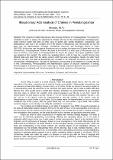Illocutionary Acts Analysis of Chinese in Pematangsiantar
Abstract
This research is entitled Illocutionary Acts Analysis of Chinese in Pematangsiantar. This research is conducted in order to analyze the utterances of Chinese who live in Hos Cokroaminoto, Pematangsiantar. Austin (1975:3) stated that there are three types of speech acts, namely locutionary, illocutionary, and perlocutionary acts. But in this occasion, the writer focuses to illocutionary acts. Illocutionary act has five types, they are representatives, directives, commissives, expressive, and declarative (Searle in Leech, 1983:205). So the writer uses the types of illocutionary acts to analyze the utterances of Chinese who live in Hos Cokroaminoto, Pematangsiantar. Problem discussed in this research is what types of illocutionary acts are found on Chinese conversation in Pematangsiantar? To answer the problem, Descriptive qualitative method was adapted in this research. The writer uses sampling data in order to make the research become more efficient. Data were taken from the various contexts which has some conversations. Finally, the writer found that there are only four types of illocutionary acts occurred in the utterances of Chinese who live in Hos Cokroaminoto, Pematangsiantar. The types of illocutionary acts occurred in the utterances of Chinese who live in Hos Cokroaminoto, Pematangsiantar are Representative (typical of structure expressions of asking), Directive (typical of structure expressions of ordering and inviting), Expressive (typical of structure expressions of greeting and compliment), and Commissive (typical of structure expressions of threatening).

